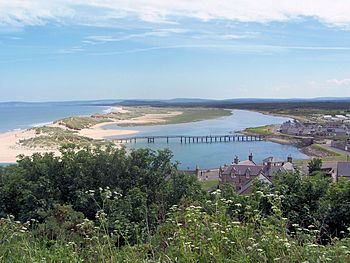River Lossie facts for kids
Quick facts for kids River Lossie |
|
|---|---|
 |
|
| Country | Scotland |
| Physical characteristics | |
| Main source | Hills above Dallas, Moray 400 m (1,300 ft) |
| River mouth | Lossiemouth into Moray Firth |
| Length | 50 km (31 mi) |
| Basin features | |
| Basin size | 213 km2 (82 sq mi) |
The River Lossie (which is called Uisge Losaidh in Scottish Gaelic) is a cool river located in the northeast part of Scotland. It starts high up in the hills near a place called Dallas in Moray. The river's source is about 400 meters (or 1,312 feet) above sea level!
From its start, the River Lossie flows for about 50 kilometers (around 31 miles). It eventually reaches the sea at a town called Lossiemouth. Here, it flows into the Moray Firth, which is a large bay on the coast of Scotland.
As the river travels through towns like Elgin, it becomes very slow. The ground between Elgin and Lossiemouth is almost flat. This means the river drops less than 5 meters (about 16 feet) in height over this long stretch. This gentle slope makes the water move very calmly.
What's in a Name? The River Lossie's History
The name of the River Lossie is very old. People wrote it down as Loscyn or Lostyn way back in the year 1189. Experts think the name might come from the Pictish language. The Picts were an ancient group of people who lived in Scotland a long, long time ago.
The ending -yn in the old names is like a special word ending from the Pictish language. It's similar to the -in ending you might find in the Welsh language today. The first part of the name, Los-, could mean a few things. It might be related to a Welsh word for "tail" or "spear." Or, it could come from a word meaning "burning." It's a bit of a mystery!
Some people have also wondered if the River Lossie is the same river that an ancient Greek mapmaker named Ptolemy called the Loksa. However, most experts now think that the River Findhorn, another river in Scotland, is a more likely match for Ptolemy's Loksa.
Journey Through Towns: Settlements Along the Lossie
The River Lossie flows past several towns and villages as it makes its way to the sea. These settlements have grown up along the river's banks, often using the river for water or transport in the past.
Here are some of the main places the River Lossie passes, listed from where it starts in the south to where it meets the sea in the north:
- Dallas: This is one of the first villages the river flows near, high up in the hills.
- Kellas: A small community further downstream.
- Paddockhaugh: Another small settlement along the river's path.
- Pittendreich: A place where the river continues its journey.
- Elgin: This is a much larger town, and as the river flows through Elgin, it slows down a lot.
- Calcots: A village located closer to the coast.
- Lossiemouth: This is where the River Lossie finally reaches the Moray Firth and flows into the sea. It's a coastal town known for its harbor.
These towns and villages show how important the River Lossie has been to the people living in Moray over many centuries.

